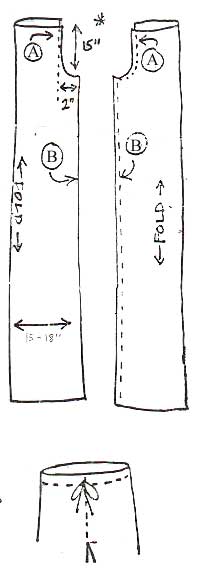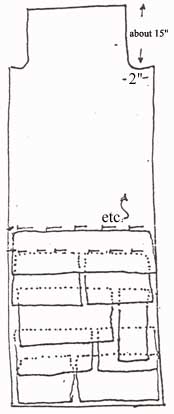Pants without fringe
1. Try to buy fabric that is 60'' wide (adults only). Buy yardage to equal your measurement from waist to floor, plus the height of your stilts from foot to floor. If you can only get fabric that is 45" wide, double the yardage.
2.Cut two pieces 30" wide and as long as your waist to floor plus stilt height measurement. Fold the two pieces in half lengthwise (print or nicer side of fabric inside) and cut a crotch to look like this:
3.Sew seam A on each piece to form the two pant legs.
4.Place legs together with outside of fabric face to face and sew seam B
5.Hem waist, leaving a tube about 3/4" wide for elastic band or string tie.
6.Hem bottom of each leg. Pants should reach to about 3-4" above the ground when they're worn.
"These measurements are for average women. Add or subtract an inch in crotch depth if you are big or little, add an inch to crotch width if you are big. If you are a really big or skinny person, trash this pattern and use a pair of your own pants to measure.

How to make fringe pants
1.Follow step 1 and 2 of "Pants without fringe" so you have two pieces of fabric like this (see picture at right).
2.Lay pieces of the fringe material across each pant leg in layers (it is easiest to start at the bottom and work your way up), OVERLAPPING EACH OTHER. The material should not be cut into fringes yet. Leave about an inch of margin along the edges and the bottom for ease when constructing the pants later.
3.Once you have laid out both legs and are satisfied with the patterns, pin down all the pieces across their top edge. This time it is easiest to start at the top and work down the leg, flipping each layer back after pinning it.
4.Sew across the top edge of each layer, being careful not to catch other layers while sewing.
5.Now construct the pants as in steps 3-6 on How To Make Stilt Pants. Sew the pants together with the fringes in the inside, and be careful not to catch the fringe fabric in the seam while sewing.
6.When your pants are completed and the bottom hemmed, cut your fringes to the desired width. Some materials are easy to tear, others must be cut. Using good fabric scissors will make this task faster.
